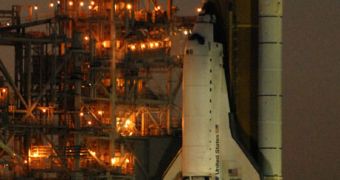Faulty external liquid fuel tank sensors have been haunting the space shuttles for more than two years now; however, is seems NASA did not give much attention to such detail until now. Upon testing them during a fill up of the external tank this Tuesday, engineers have detected a problem with a bad connector. Nevertheless, NASA officials haven't been able to point when the space shuttle Atlantis would be able to fly next month.
After failing to launch during the two attempts that took place on December 6th and 9th, NASA has decided to make a full inspection of the critical fuel gauges, and has delayed the launch until January 10th, next year. It seems however, that though the source of the problems has been found, they are uncertain whether or not it can be fixed until then, thus the mission designed to launch of the European space module Columbus could be further delayed.
During this time, the crew on board the International Space Station was given the mission to effectuate a spacewalk in order to inspect the damaged rotary joint that supported one of the space station's solar panels. What seemed to be a micrometeorite strike, due to the secondary failure of a mechanical system on the same joint, was quickly dismissed by Commander Peggy Whitson, as no sign of impact was present. Several tests of the mechanism involved unplugging multiple components from the power source, which revealed that the most probable source of the defection could be motor actuator.
It seems that such a motor might have already been present on board the space station between the spare parts, however NASA official stated that it would probably be replaced during the STS-122 mission, because of the increased difficulty of the procedure.
The rotary joint seems to be more problematic, as during its inspection, which involved removing several parts of the mechanism, the crew still found no evidence of failure, except for more of the mysterious metal shavings. The repair procedure will probably take place in the fall of the next year, and can involve as much as four spacewalks, plus training a special crew to undertake the procedure.
While the dilemma continues, NASA evaluates the possibility that the ISS would not be able to produce enough electric energy, to power the Japanese module that is scheduled to launch in February. During the test on Tuesday, two of the fuel gauge sensors failed upon filling the tank, indicating a possible sensibility to extreme cold, while another did not work at all. In case they decide to bring the shuttle back to the hangar for extensive repairs, the STS-122 mission could suffer further delay.
NASA is under extreme pressure from the U.S. government, to complete the ISS by the year 2010, in order to replace the old space shuttles.

 14 DAY TRIAL //
14 DAY TRIAL //